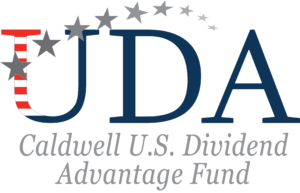Month End Recap:
For the month of April, the Caldwell U.S. Dividend Advantage Fund (UDA or Fund) declined -7.1% versus a decline of -4.7% for the S&P 500 Total Return Index (Index)1. From a sector standpoint, Information Technology, Consumer Staples, Communications Services were relative outperformers, whereas Energy, Healthcare, and Materials underperformed.
Top performers in the month of April were Quanta Services (PWR), Walmart (WMT), and Broadcom (AVGO)2. PWR has performed well, aided by a modest guidance increase, in addition to its backlog now sitting at a record $35.3 billion, driven by additional volumes with existing customers as well as new projects–supporting continued growth. WMT held up well during recent market volatility, as the company’s price leadership positions it well to acquire incremental market share with low-income consumers, in the case of softening economic conditions. AVGO rerated higher, driven by a series of positive catalysts including a $10 billion share buyback signaling management confidence, a sharp rebound from tariff-related declines after Trump announced a 90-day pause on new tariffs, advancements in its AI-powered cybersecurity offerings, and easing trade war fears.
During the month of April, the Fund initiated positions in TJX Companies (TJX), Quanta Services (PWR), and Agnico Eagle Mines (AEM).
TJX is the largest off-price retailer in the U.S., offering apparel, footwear, jewelry, and home goods through its well-known banners—including T.J. Maxx, Marshalls, Winners, and HomeGoods—across approximately 4,700 stores. The company is well-positioned in the current retail environment, benefiting from a potential excess inventory backdrop created by pre-tariff buying, which could provide attractive sourcing opportunities. Its strong relative value proposition versus full-price retailers—who may face greater pricing pressure from tariffs—supports continued consumer trade-down and volume growth. Additionally, smaller brands more exposed to tariff impacts and supply chain delays are likely to lose share to larger, more agile players like TJX.
PWR is a leading North American infrastructure specialty contractor, offering a broad range of services—including engineering, construction, installation, maintenance, and upgrades—across utility transmission and distribution, renewable energy, and communications sectors. The company is poised for continued growth, supported by strong demand across technology, power generation, and energy storage markets. It is benefiting from accelerated investment in high-voltage transmission and renewable energy infrastructure, with a favourable long-term backdrop driven by the need to modernize and expand the grid to meet growing energy demands.
AEM is a Canadian gold producer operating two of the largest gold mines in Canada with assets located in Canada, Australia, Mexico, and Finland, which are jurisdictions that are safe politically. The currently elevated gold prices provide an attractive environment for the for the company to generate strong cash flows, enabling continued deleveraging and progress toward its goal of becoming nearly debt neutral.
The Fund held a 23.8% cash weighting at month-end. While we remain mindful of the macro environment, the Fund employs a bottom-up investment approach designed to seek out attractive investment opportunities in any market. Over the long run, given its unique momentum-driven investment approach and focus on well-managed, dividend growth companies, we believe UDA is well-positioned to provide strong performance by way of both attractive regular monthly distributions and long-term capital appreciation potential. We expect that our approach to dividend growth investing should continue to provide a means of generating compelling risk-adjusted returns for our investors over the long term.
1All returns (for the fund, individual stocks and sectors) are in total return, Canadian dollar terms. All stock returns represent performance for the full period noted. All fund returns are in respect of Series F.
Standard performance as at March 31, 2025:
Caldwell U.S. Dividend Advantage Fund (Series F): 1 Year: -7.2%, 3 year: 5.2%, 5 year: 7.1%, Since Inception (June 19, 2015): 7.2%.
S&P500 Total Return Index: 1 Year: 12.7%, 3 year: 15.1%, 5 year: 15.5%, Since Inception (June 19, 2015): 13.7%.
2Actual investments, first purchased: PWR 4/10/2025, WMT 2/13/2025, AVGO 11/15/2022.
All data is as of April 30, 2025 sourced from Morningstar Direct or S&P Capital IQ, unless otherwise indicated. Fund returns are from FundData. UDA, Index total return numbers, sector returns and individual stocks returns are in CAD terms. The Fund was first offered to the public as a closed-end investment since May 28, 2015. Effective November 15, 2018 the Fund was converted into an open-end mutual fund such that all units held were redesignated as Series F units. Performance prior to the conversion date would have differed had the Fund been subject to the same investment restrictions and practices of the current open-end mutual fund.
The information contained herein provides general information about the Fund at a point in time. Investors are strongly encouraged to consult with a financial advisor and review the Simplified Prospectus and Fund Facts documents carefully prior to making investment decisions about the Fund. Commissions, trailing commissions, management fees and expenses all may be associated with mutual fund investments. Rates of returns, unless otherwise indicated, are the historical annual compounded returns including changes in unit value and reinvestment of all distributions and do not take into account sales, redemption, distribution or optional charges or income taxes payable by any unitholder that would have reduced returns. Mutual funds are not guaranteed; their values change frequently and past performance may not be repeated. The payment of distributions should not be confused with a fund’s performance, rate of return or yield. If distributions paid are greater than the performance of the fund, your original investment will shrink. Distributions paid as a result of capital gains realized by a fund, and income and dividends earned by a fund, are taxable in your hands in the year they are paid. Your adjusted cost base (“ACB”) will be reduced by the amount of any returns of capital and should your ACB fall below zero, you will have to pay capital gains tax on the amount below zero.
Publication date: May 20, 2025.

